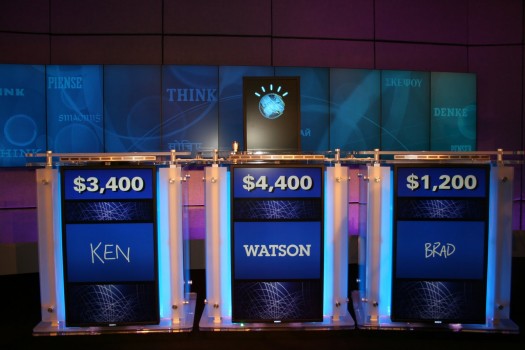If asked whether data can be beautiful, many of us in the art world would give the questioner a quizzical look. We would then proceed to answer along the lines of “In the art world, we do not ponder over the beauty of data.” But if we were to pose the same question to IBM, they would nod affirmatively. And it bodes well for us to listen to those at IBM because after a century of trial and error, they have agreed to share some of the reasons behind why data is not only beautiful, but also powerful and astonishing. In celebration of a century of avant-garde thinking, the aptly named IBM THINK exhibit is on display at the Lincoln Center in New York. One of the most striking displays is found at the entrance itself; an incredibly beautiful, 123 foot, digital data wall that “visualizes, in real time, the live data streaming from the systems surrounding the exhibit, from traffic on Broadway, to solar energy, to air quality.”
Once inside the exhibit, which is a veritable visual feast, visitors watch a 12 minute film about “awe inspiring stories of the past and the present”; in essence visitors learn about how the advancements made at IBM have shaped the technological course of the 20th century and the opportunities that lie for “making our world better, today.”
- The exhibit concludes with an interactive experience, where visitors can delve into the collective knowledge of the scientific and tech world, from “clocks and scales to microscopes and telescopes, RFID chips and biomedical sensors”, on 40 seven foot screens. Through its data visualization techniques and compelling interactive experiences, the IBM THINK exhibit achieves a rare balance between data analysis and beauty.
http://www.youtube.com/watch?v=JVrXAsYd1Wk
But the overall theme of the exhibit is not limited to the dissemination of data, rather it poses a grandiose and rather formidable question; how do we use the breakthroughs in the fields of science, technology, and leadership to make the planet a smarter place? So while the BMW Guggenheim Lab experimented with making metropolises better, IBM’s sets its sights on the well-being of the entire world. Is that an audacious quest? Not quite, because if IBM were a person, they would have on their resume, a century of experience in changing the world, written under qualifications.
In fact, not only has IBM propelled the world into the 21st century, it continues to build up storms in the ever restive sea of our scientific and technological present. For instance, it’s hard to ignore Watson, the IBM self–contained computer system that proves that computers too are capable of placing themselves in jeopardy. This is because Watson can process natural language and hypothesize between answers, until it arrives at the right answer through weighing different algorithms and determining its confidence level. And Dr. David Ferrucci, the Principal Investigator for the Watson project, is convinced that computer has potential to transform industries such as business and health care.
Let’s also take a look at a technology that may not have created a storm, but perhaps ripples in the much smaller lake of the art world. Earlier this summer, IBM helped the Metropolitan Museum of Art make quantum leaps in art preservation when it installed wireless environmental sensors called Low-Power Motes. These sensors will help the Met monitor the micro-environment through real-time 3D data that will “measure temperature, humidity, air flow, contamination levels, door positions, light levels, and more.” The sensors will help the museum scientists develop correlation models between environmental conditions and the reactions they have on works of art, eventually leading to better models for art preservation.
So in the end, let’s not move forward but backwards. Let’s rewind our clocks back to the year 1911, when IBM’s successor the Computing Tabulating Recording Corporation sold products such as employee time keeping systems, punched card equipment, and of all things, automatic meat slicers! Compare meat slicers to Watson or Low-Power Motes and we can begin to appreciate the beauty of data analysis techniques and technological advancements. We can finally begin to nod in unison with IBM.







